Medicare Covers FreeStyle Libre 3 CGM by Andrew Briskin and April Hopcroft for diaTribe.org, 4 August 2023.
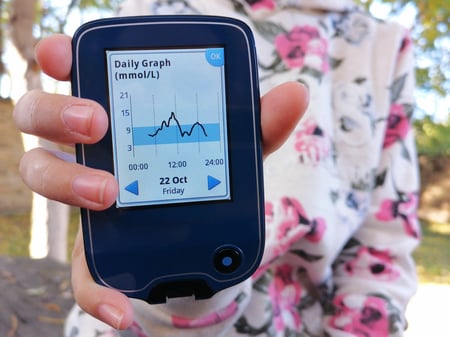 Abbott has announced that its latest continuous glucose monitor, the FreeStyle Libre 3, is now covered under Medicare. Following news in April that the FDA cleared a separate handheld reader for Abbott’s latest continuous glucose monitoring (CGM) system, the FreeStyle Libre 3, Abbott has announced that the Libre 3 system is now available for people on Medicare.
Abbott has announced that its latest continuous glucose monitor, the FreeStyle Libre 3, is now covered under Medicare. Following news in April that the FDA cleared a separate handheld reader for Abbott’s latest continuous glucose monitoring (CGM) system, the FreeStyle Libre 3, Abbott has announced that the Libre 3 system is now available for people on Medicare.
This announcement follows Medicare’s April 2023 expansion of CGM coverage to include people with type 2 diabetes. Based on this expansion, Abbott estimates that an additional two million people will now have access to the Libre 3 CGM system, which has been shown to improve health outcomes, including Time in Range.
The Libre 3 was previously ineligible for Medicare coverage because it did not include a separate handheld reader. Before the reader was cleared in April 2023, Libre 3 users could only use a smartphone app to view their glucose readings.
Read more: Medicare Covers FreeStyle Libre 3 CGM
Senseonics seeks iCGM designation for implantable glucose monitor by Elise Reuter for MedTechDive.com, 11 August 2023. The designation would allow the company’s device to work with insulin pumps and smart pens.
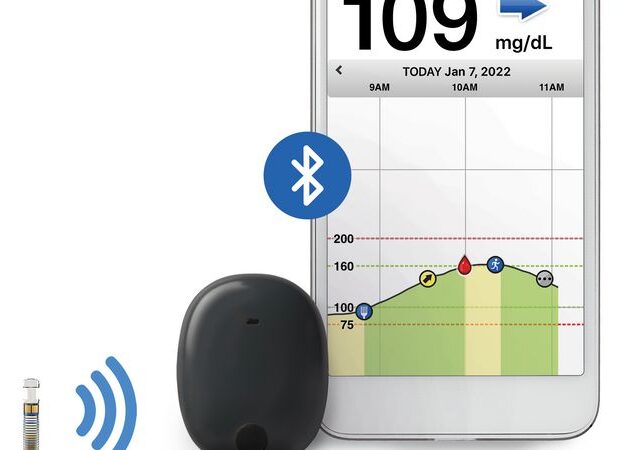 Senseonics expects approval for the iCGM designation in early 2024, said CEO Tim Goodnow. He did not disclose which pump companies Senseonics will partner with, noting that the company “has a number of development programs currently in place,” and that insulin pens are also an important consideration, given that more people use them.
Senseonics expects approval for the iCGM designation in early 2024, said CEO Tim Goodnow. He did not disclose which pump companies Senseonics will partner with, noting that the company “has a number of development programs currently in place,” and that insulin pens are also an important consideration, given that more people use them.
Senseonics is also nearing the end of its Enhance trial, which is designed to evaluate the accuracy and safety of a version of its sensor that can be worn for 365 days. Goodnow said the last patient evaluation visits will be finished in September. The company plans to make an FDA submission for the longer-duration sensor in early 2024.
Read more: Senseonics seeks iCGM designation for implantable glucose monitor
Better understanding of women’s hormonal changes may improve diabetes management by Erin T. Welsh for Healio.com/womens-health-ob-gyn, 7 August 2023.
 Women’s various hormonal changes throughout their lifetime can make their diabetes management more complex compared with men, according to a presenter at the Association of Diabetes Care and Education Specialists annual meeting.
Women’s various hormonal changes throughout their lifetime can make their diabetes management more complex compared with men, according to a presenter at the Association of Diabetes Care and Education Specialists annual meeting.
“As a clinician, I noticed a great gap in management of diabetes in women, and I came to realize the importance of understanding women’s specific risk factors to provide a better client-centered care,” said Nazli Parast, RN, CDE, BScN, MScN, EdD, an advanced practice nurse and certified diabetes educator in the women’s heart health and hypertension clinics at the University of Ottawa Heart Institute. According to Parast, simply including women in research studies is insufficient because women present with different challenges at different times in their life — before, during, after pregnancy and menopause. This includes different changes in diabetes management compared with men. Parast also highlighted that women with diabetes often have more to manage :
-
-
- higher risks for heart disease and other diabetes-related complications;
- higher risk for developing yeast and urinary tract infections;
- difficulty with glycemic management due to hormonal changes before and during menstruation;
- increased pregnancy complication risk with diabetes; and
- unpredictable elevations and drops in glucose due to reductions in estrogen during premenopause and menopause.
-
Read more: Better understanding of women’s hormonal changes may improve diabetes management
Forget 10,000 steps – walking just 5,000 is enough to lower your risk of death by Noa Leach for ScienceFocus.com, 8 August 2023.
 A new study reveals that health benefits start when you take as few as 3,967 daily steps – including reducing your risk of dying from a range of causes. The research also found that a minimum of 2,337 steps was enough to reduce the risk of death from cardiovascular diseases. These diseases affect the heart and blood vessels and can cause heart attacks. Published in the European Journal of Preventive Cardiology, the paper brought together data from 17 existing studies involving 226,889 people.
A new study reveals that health benefits start when you take as few as 3,967 daily steps – including reducing your risk of dying from a range of causes. The research also found that a minimum of 2,337 steps was enough to reduce the risk of death from cardiovascular diseases. These diseases affect the heart and blood vessels and can cause heart attacks. Published in the European Journal of Preventive Cardiology, the paper brought together data from 17 existing studies involving 226,889 people.
It’s the first to assess the impacts of walking up to 20,000 steps a day, as well as whether the risk of dying differs depending on age, sex, or where in the world people live. The answer? The study found that the more you walk, the better – regardless of your age, sex, or the climatic conditions of your region.
Read more:
Pharma under threat from bill to expand drug price negotiations by Jonathan Block for SeekingAlpha.com, 13 August 2023.
 A recently introduced piece of legislation in the House that would allow drug price negotiations and inflation rebates on behalf of those with private insurance could potentially harm pharma companies’ bottom line. The Lowering Drug Costs for American Families Act (H.R. 4895), introduced by a trio of Democrats — Frank Pallone (N.J.), Richard Neal (Mass.), and Robert Scott (Va.) — in late July aims to expand drug cost relief measures for Medicare seen in the Inflation Reduction Act to those insured privately.
A recently introduced piece of legislation in the House that would allow drug price negotiations and inflation rebates on behalf of those with private insurance could potentially harm pharma companies’ bottom line. The Lowering Drug Costs for American Families Act (H.R. 4895), introduced by a trio of Democrats — Frank Pallone (N.J.), Richard Neal (Mass.), and Robert Scott (Va.) — in late July aims to expand drug cost relief measures for Medicare seen in the Inflation Reduction Act to those insured privately.
If passed by the House and Senate and signed into law, it could potentially benefit 164M people who receive health coverage through their jobs and more than 16M individuals who have coverage through health insurance marketplaces. In a news release, the congressmen note that the drug rebate savings alone for those in private insurance plans would be as much as $40B over the next 10 years.
The bill is aggressive in terms of the number of drugs that would be subject to negotiation — 50. The Inflation Reduction Act calls for just 10 drugs to be negotiated for Medicare Part D starting in 2026, though that number would increase in subsequent years.
The drug industry trade group, Pharmaceutical Research and Manufacturers of America (PhRMA), as well as several drugmakers, including Johnson & Johnson, Merck, and Bristol-Myers Squibb, are challenging Medicare drug price negotiations in the courts.
Read more: Pharma under threat from bill to expand drug price negotiations
Synergistic effect of a traditional Chinese medicinal compound on existing diabetes drug found by Justin Jackson for MedicalExpress.com, 9 August 2023.
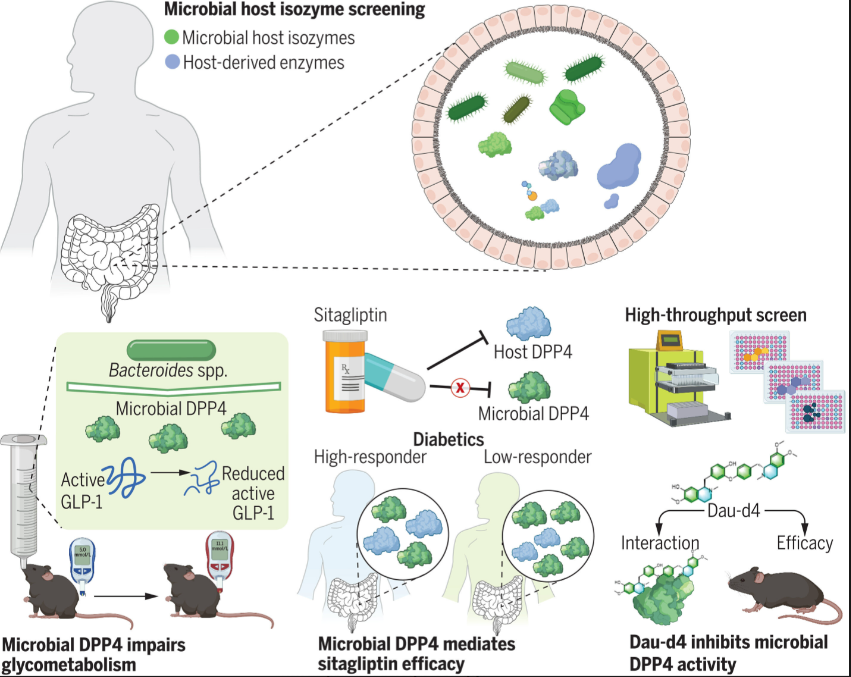 Research led by Peking University, China, has looked into gut microbiota production of isozymes, which do similar work to human enzymes but have different structures. In a paper titled “Microbial-host-isozyme analyses reveal microbial DPP4 as a potential antidiabetic target,” published in Science, the team details interactions of microbiota isoenzyme cross-species regulation of metabolic disease surrounding type 2 diabetes, the diabetes drug sitagliptin and a compound derived from traditional Chinese medicine.
Research led by Peking University, China, has looked into gut microbiota production of isozymes, which do similar work to human enzymes but have different structures. In a paper titled “Microbial-host-isozyme analyses reveal microbial DPP4 as a potential antidiabetic target,” published in Science, the team details interactions of microbiota isoenzyme cross-species regulation of metabolic disease surrounding type 2 diabetes, the diabetes drug sitagliptin and a compound derived from traditional Chinese medicine.
Gut microbiota can produce enzymes with functions similar to those produced by the body. These microbial isozymes can regulate physiology and pathophysiology as they assist or detract from regular enzyme interactions.
In searching for these interactions, the research team identified 71 enzymes with activity in human gut bacteria communities. They found species of Bacteroides producing microbial dipeptidyl peptidase 4 (mDPP4). The human version of DPP4 plays a significant role in regulatory processes such as T-cell homeostasis and metabolism. In the metabolism, DPP4 has a direct role in degrading the hormone GLP-1.
Glucagon-like peptide-1 (GLP-1) is a hormone that is released after eating a meal. GLP-1 decreases blood glucose by suppressing glucagon secretion and may be involved in glucose-dependent stimulation of insulin release. These actions lower blood sugar levels, which helps control type 2 diabetes and acts as an appetite suppressor. To increase the half-life and effectiveness of GLP-1 activity in type 2 diabetes patients, drugs like sitagliptin that inhibit DPP4 have been used.
Read more: Synergistic effect of a traditional Chinese medicinal compound on existing diabetes drug found
Lack of green space may be linked to high BP in people with type 1 diabetes by Michael Monostra for Healio.com/endocrinology, 6 August 2023.
 People with type 1 diabetes who lived in areas with little green space were more likely to have high blood pressure, but odds were lower for those exposed to more air pollution, according to study data.
People with type 1 diabetes who lived in areas with little green space were more likely to have high blood pressure, but odds were lower for those exposed to more air pollution, according to study data.
In an analysis of data from the T1D Exchange clinic registry, presented at the Association of Diabetes Care and Education Specialists annual meeting, researchers analyzed associations between environmental risk factors and high BP among adults and adolescents with type 1 diabetes. Jorden Rieke, BSN, RN, CCRN, a nursing PhD student and predoctoral fellow at the Frances Payne Bolton School of Nursing at Case Western Reserve University in Cleveland, said the findings were mixed: People living in areas with little vegetation had higher odds of high BP, but those living in areas with more air pollution had lower odds for elevated BP in this sample.
“This study is a first step for showing us some relationships, but we need to do more, and we need to look at different types of [study] designs to get the answers we’re looking for,” Rieke said.
Read more: Lack of green space may be linked to high BP in people with type 1 diabetes
GLP-1 Agonists May Hasten Progression of Diabetic Retinopathy by Dr. Kamal Kant Kohli for MedicalDialogues.in, 6 August 2023.
 Studies have linked the use of GLP-1 receptor agonists with exacerbation of macular disease that frequently occurs in diabetes patients. Glucagon-like peptide-1 receptor agonists (GLP-1 RAs) are a family of drugs used to treat type 2 diabetes mellitus (T2DM) and are now also being used for promoting weight loss.
Studies have linked the use of GLP-1 receptor agonists with exacerbation of macular disease that frequently occurs in diabetes patients. Glucagon-like peptide-1 receptor agonists (GLP-1 RAs) are a family of drugs used to treat type 2 diabetes mellitus (T2DM) and are now also being used for promoting weight loss.
The two studies presented at the 2023 annual meeting of the American Society of Retina Specialists revealed that using injectable GLP-1 receptor agonists appears to hasten the progression of diabetic macular edema (DME) and diabetic retinopathy. In patients with and without diabetes, GLP-1 agonists can promote considerable weight loss. Moreover, the finding that sodium-glucose transporter-2 (SGLT-2) inhibitors, also known as gliflozins improve renal and cardiovascular function in type 2 diabetes patients has accelerated the use of these agents for blood sugar control.
Key findings include
-
-
- Patients taking GLP-1 inhibitors had higher conversion rates to PDR than those taking gliflozins at three years (6% versus 4%).
- Nearly 25% of those taking a GLP-1 agonist had progressed to DME after 3 years, compared with 18% of those taking a gliflozin.
- People in the group taking GLP-1 inhibitors also had a greater need for interventions than those on a gliflozin; 8% vs roughly 6%, respectively, required intravitreal injections.
-
Read more: GLP-1 Agonists May Hasten Progression of Diabetic Retinopathy
How to satisfy our sweet tooth with less sugar, by Abigail Klein Leichman for Israel21c.org, 8 August 2023. A new WHO warning against artificial sweeteners puts innovative Israeli solutions for sugar reduction in the spotlight.
 While the WHO advises us “to consider other ways to reduce free sugars intake, such as consuming food with naturally occurring sugars, like fruit, or unsweetened food and beverages,” the food and beverage industry still needs to satisfy the world’s sweet tooth. Israeli companies are on the case, with a variety of products on the market or in development to reduce the consumption of added sugar.
While the WHO advises us “to consider other ways to reduce free sugars intake, such as consuming food with naturally occurring sugars, like fruit, or unsweetened food and beverages,” the food and beverage industry still needs to satisfy the world’s sweet tooth. Israeli companies are on the case, with a variety of products on the market or in development to reduce the consumption of added sugar.
1. DouxMatok tinkered with the way sugar is delivered to the taste buds, resulting in Incredo Sugar, a product that enables manufacturers to use 30 to 50 percent less sugar without sacrificing the perception of sweetness. Recently, the company raised $30 million in Series C funding round and rebranded as Incredo. Incredo Sugar – How Does It Work?
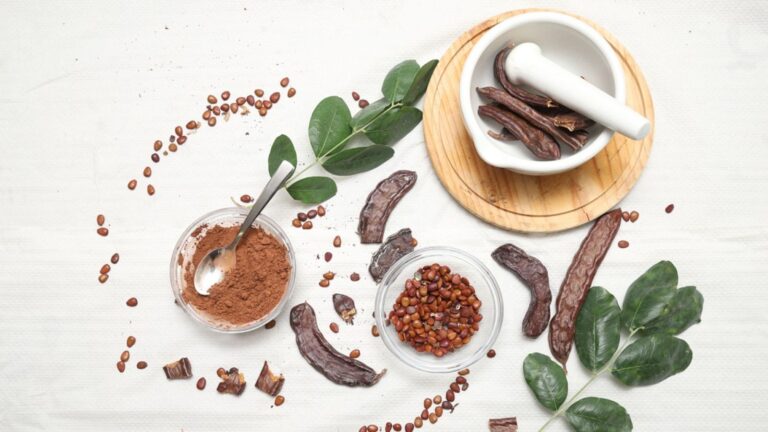 2. CarobWay debuted its low glycemic index sweetener at the IFT FIRST 2023 trade show in Chicago in July. The syrup, derived from whole carob fruit, provides a mild caramel flavor and promotes well-being too. “You can plug our natural sugar easily into almost any food and beverage application,” said Udi Alroy, CEO and co-founder of CarobWay. “Many carob sweeteners can have a faint bitter note, but CarobWay’s sweetener is clean and flavorful.” The syrup contains natural sugars and D-pinitol, an organic compound with a sweetness about 50% that of sucrose. D-pinitol has been shown to lower blood glucose levels, among other health benefits such as supporting immunity and liver health. “This is good news for prediabetics who desire to enjoy pastry confections and sweets,” says Monica Colt, scientific director for CarobWay.
2. CarobWay debuted its low glycemic index sweetener at the IFT FIRST 2023 trade show in Chicago in July. The syrup, derived from whole carob fruit, provides a mild caramel flavor and promotes well-being too. “You can plug our natural sugar easily into almost any food and beverage application,” said Udi Alroy, CEO and co-founder of CarobWay. “Many carob sweeteners can have a faint bitter note, but CarobWay’s sweetener is clean and flavorful.” The syrup contains natural sugars and D-pinitol, an organic compound with a sweetness about 50% that of sucrose. D-pinitol has been shown to lower blood glucose levels, among other health benefits such as supporting immunity and liver health. “This is good news for prediabetics who desire to enjoy pastry confections and sweets,” says Monica Colt, scientific director for CarobWay.
The syrup contains natural sugars and D-pinitol, an organic compound with a sweetness about 50% that of sucrose. D-pinitol has been shown to lower blood glucose levels, among other health benefits such as supporting immunity and liver health.
3. Ambrosia Bio is working toward the scalable and affordable production of allulose, a naturally sweet carbohydrate. Small amounts of allulose are found in figs, raisins, wheat, maple syrup and molasses. It can replace table sugar one-to-one, with up to 95 percent fewer calories and virtually no effect on blood glucose. Allulose could be used in both solid and liquid products that would be labeled “no added sugar,” a critical marketing claim. However, allulose was only approved by the FDA in 2019 as a sugar replacement and isn’t cheap or abundant enough to supply big companies interested in using it.
Ambrosia Bio proposes producing allulose from low-cost feedstock (sucrose, starch, or even food manufacturing side streams) using an enzyme catalyst. Founder and CEO Ziv Zwighaft says the company plans to help clients revamp existing sugar refineries to produce allulose, providing “everything for the process from raw materials to engineering.”
4. Better Juice recently completed pilot trials of its sugar-reduction beads for fruit juices, in partnership with food-processing technology giant GEA Group in Germany. Dozens of American, European, Australian and Brazilian manufacturers successfully reduced simple sugar content by up to half in strawberry, cherry and blueberry juices, while preserving their flavor, texture and nutritional value. “Fruit juices contain 10% or more sugar, with berry and cherry juices comprised of 10% to 20% sucrose and the remainder fructose and glucose,” explains Eran Blachinsky, cofounder and co-CEO of Better Juice. “Our technology reduces loads of all three of these simple sugars.” The sugar-reduction beads are non-GMO microorganisms that naturally convert the juice’s sugars into prebiotic oligosaccharides and other non-digestible fibers.
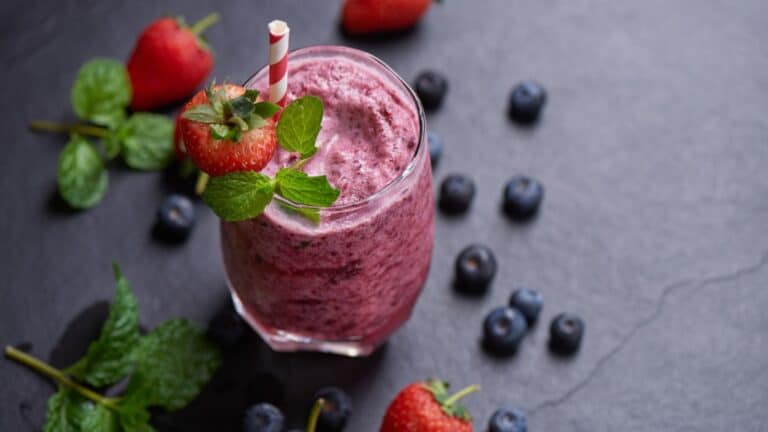 5. Amai Proteins has won multiple awards for redesigning sweet proteins found in the jungle into a mass-market sugar substitute that tastes just like sugar. Amai means “sweet” in Japanese. “Our first product, Sweelin, is a sustainable, 100% sweet protein that can reduce 40% to 70% of added sugar in a wide variety of food and beverages, without changing the consumer taste experience,” said CEO and founder Ilan Samish. “The novel proteins mimic proteins that reside in harsh conditions, such as the Dead Sea, hot springs or acidic swamps, and are thus fit for the requirements for the mass food market.” VIDEO: Amai Proteins
5. Amai Proteins has won multiple awards for redesigning sweet proteins found in the jungle into a mass-market sugar substitute that tastes just like sugar. Amai means “sweet” in Japanese. “Our first product, Sweelin, is a sustainable, 100% sweet protein that can reduce 40% to 70% of added sugar in a wide variety of food and beverages, without changing the consumer taste experience,” said CEO and founder Ilan Samish. “The novel proteins mimic proteins that reside in harsh conditions, such as the Dead Sea, hot springs or acidic swamps, and are thus fit for the requirements for the mass food market.” VIDEO: Amai Proteins
6. Sante from Lycored is a natural tomato-derived concentrate that enhances taste and reduces the need for added sugar and salt in food products. It’s available in liquid and powder form. Lycored notes that Sante is approved as a flavoring in the US and EU, certified kosher and halal, and can help manufacturers “clean up your nutrition facts panels and remove added sugars from your ingredients list.”
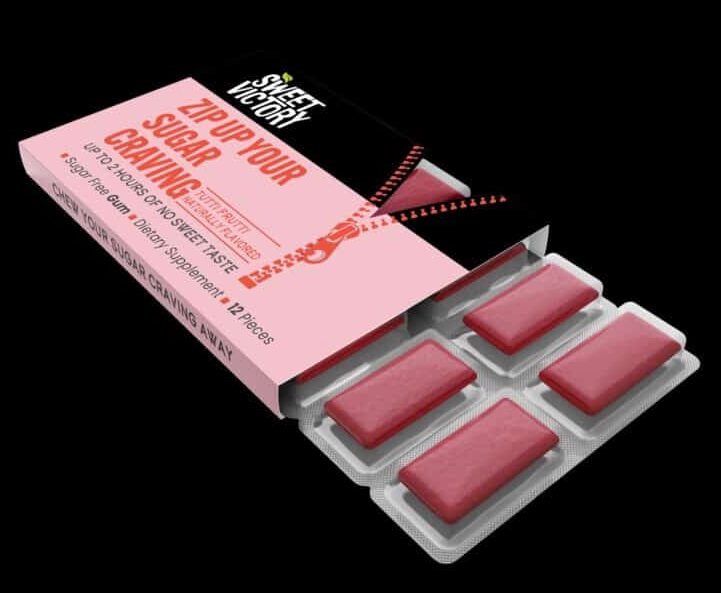 7. Sweet Victory botanical chewing gum, designed to curb sugar cravings, keeps racking up awards – most recently, winning the distinction of “Most Innovative Finished Nutraceutical Product” at the Vitafoods Europe Innovation Challenge 2023. The active ingredient is a native Indian natural botanical, gymnema (Gymnema sylvestre), known in traditional medicine as the “sugar destroyer” due to its ability to block the tongue’s taste receptors for sweetness and slow intestinal absorption of sugars.
7. Sweet Victory botanical chewing gum, designed to curb sugar cravings, keeps racking up awards – most recently, winning the distinction of “Most Innovative Finished Nutraceutical Product” at the Vitafoods Europe Innovation Challenge 2023. The active ingredient is a native Indian natural botanical, gymnema (Gymnema sylvestre), known in traditional medicine as the “sugar destroyer” due to its ability to block the tongue’s taste receptors for sweetness and slow intestinal absorption of sugars.
In an independent consumer study of 80 participants, more than 80% reported cutting down on their intake of sweets by chewing Sweet Victory at least three times a day, either after meals, between meals, or whenever experiencing a sugar craving. Nine out of 10 participants reported measurable weight loss during the two-week trial. “A significant decrease in the consumption of sweets was observed from the fourth day until the end of the experiment compared to the first days, suggesting an enduring effect,” said cofounder and psychologist Gitit Lahav.
8. Fruitlift from Gat Foods, a natural liquid composed of 90% fruit components, replaces table sugar fully or partially in breakfast cereals. Most breakfast cereals contain 15% to 40% refined sugar. Fruitlift can be added to flour mixtures of puffed cereals in a variety of mild fruity flavors or sprayed onto finished cereal. Each formulation can be designed according to the manufacturer’s needs. Fruitlift was conceived for Gat Foods by Practical Innovation, an Israeli company that finds new growth engines for traditional industries, in this case, fruit-based beverage and food solutions.
Read more: How to satisfy our sweet tooth with less sugar
Expert Advice: What to Do When You Can’t Use Your Insulin Pump by Eritrea Mussa for diaTribe.org, 11 July 2022.
 Taking a break from your insulin pump or dealing with a pump malfunction can be a stressful experience. Dr. Ananta Addala, a pediatric endocrinologist at Stanford University, offers a checklist of things to be prepared for in the event that you can’t use your insulin pump. “In case of a site failure or pump malfunction leading to a forced break, it’s important to be systematic and thoughtful [about your approach],” said Addala. In other circumstances, a person may just want an insulin pump holiday. “There are three main reasons one may need, or want, to take a short break from a pump,” she said, including:
Taking a break from your insulin pump or dealing with a pump malfunction can be a stressful experience. Dr. Ananta Addala, a pediatric endocrinologist at Stanford University, offers a checklist of things to be prepared for in the event that you can’t use your insulin pump. “In case of a site failure or pump malfunction leading to a forced break, it’s important to be systematic and thoughtful [about your approach],” said Addala. In other circumstances, a person may just want an insulin pump holiday. “There are three main reasons one may need, or want, to take a short break from a pump,” she said, including:
-
-
- The buildup of scar tissue or a lack of viable locations for site placement.
- The need for a short mental or emotional break from diabetes technology (which can be overwhelming for some people).
- The need to remove your pump during exercise.
-
Addala recommends planning ahead, just in case, regardless of the reason for your pump break. This includes creating a “pump failure checklist.” A checklist will make sure that all those questions you have are answered, such as:
-
-
- Do you know who to call if the pump fails?
- Who should you contact or speak to?
- What supplies should you have on hand?
-
Here is an example of a“pump failure checklist,” developed with Addala:
-
-
- Contact the number for the support line of the manufacturer of your insulin pump as soon as possible, especially if your pump fails or breaks unexpectedly.
- Contact your endocrinologist or primary care physician for help figuring out your basal insulin rates and to discuss your personal “dose sheet” if you don’t already have one, which shows you how to convert your basal and bolus rates from pump to MDI. You can ask for a dose sheet in advance at any of your healthcare appointments.
- Make sure to keep emergency short-acting and long-acting insulin on hand and accessible, if possible. Addala recommends keeping emergency long-acting insulin on hand if possible. If only short-acting is available, she recommends “testing every 3 hours and taking insulin to prevent DKA.”
- Have a list of contact numbers that you keep handy, 24/7.
-
A word about dose sheets: A dose sheet can tell you how much short-acting insulin you need in order to prevent diabetic ketoacidosis (DKA) while making sure you do not take too much and cause hypoglycemia. Your dose sheet should explain how much long-acting insulin to take to replace your hourly basal rate. It should also provide an insulin-to-carb ratio for your mealtime bolus amount. If you do find yourself in a situation where you don’t have a dose sheet and are unsure of what to do, it’s important to contact your endocrinologist or primary care provider.
Preparation is key; having these resources and supplies on hand at all times can help prevent any future emergencies. Having a checklist made me feel more secure and equipped to handle a pump emergency, and can give all people with diabetes greater peace of mind when faced with this situation.
Read more: Taking a Break From Your Insulin Pump


GLP-1 Agonists May Hasten Progression of Diabetic Retinopathy that is serious scary.
The second thing, how can Pharma be in jeopardy with price negotiation? When these same manufacturers are forced by law to negotiate with countries all over the world? So long as the negotiation is fair and pharma is bidding about similar medications it will not be unfair. The question? How many of these medications that are not low price are not offered in other countries t all? Not many. Sorry I value Pharma and I believe they reserve a fair return. But this sounds like the trade group is crying wolf.